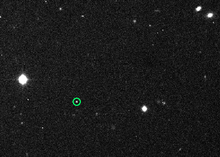S/2003 J 16
 Hình ảnh Recovery của S/2003 J 16 được chụp bởi Kính viễn vọng Canada–Pháp–Hawaii vào tháng 9 năm 2010 | |
| Khám phá [1] | |
|---|---|
| Khám phá bởi | Brett J. Gladman John J. Kavelaars Jean-Marc Petit Lynne Allen |
| Nơi khám phá | Đài quan sát Mauna Kea |
| Ngày phát hiện | 6 tháng 2 năm 2003 |
| Đặc trưng quỹ đạo [2] | |
| Kỷ nguyên 17 tháng 12 năm 2020 (JD 2.459.200,5) | |
| Cung quan sát | 15,26 năm (5574 ngày) |
| 0,1371176 | |
| Độ lệch tâm | 0,333 0999 |
| –1,64 năm (–600,18 ngày) | |
| 88,243 14° | |
| 0° 35m 59.341s / ngày | |
| Độ nghiêng quỹ đạo | 151,163 23° (so với mặt phẳng hoàng đạo) 28,836 77° (nghịch) |
| 83,263 65° | |
| 86,514 95° | |
| Vệ tinh của | Sao Mộc |
| Nhóm | Nhóm Ananke |
| Đặc trưng vật lý | |
Đường kính trung bình | ≈2 km[3] |
| Suất phản chiếu | 0,04 (giả định)[3] |
| 23,3 [3] | |
| 16,3 [2] | |
S/2003 J 16 là một vệ tinh tự nhiên của Sao Mộc. Vệ tinh này được phát hiện bởi một nhóm các nhà thiên văn học đến từ Đại học Hawaii do Brett J. Gladman dẫn đầu năm 2003.[1][4]
S/2003 J 16 có đường kính khoảng 2 km, và quay quanh Sao Mộc ở khoảng cách trung bình 0,137

Vệ tinh tự nhiên này hiện được cho là đã bị mất tích[3][5][6][7][8] cho đến tháng 9 năm 2010, khi được chụp lại bằng Kính viễn vọng Canada–Pháp–Hawaii (CFHT).[9][10] Tuy nhiên, các quan sát về sự tái xuất của S/2003 J 16 không được Minor Planet Center báo cáo cho đến năm 2020, khi Ashton và đồng nghiệp đã xác định vệ tinh này trong cùng hình ảnh chụp bằng CFHT vào tháng 9 năm 2010.[11] S/2003 J 16 cũng được xác định trong các quan sát của Scott Sheppard từ tháng 3 năm 2017 đến tháng 5 năm 2018, tích lũy một cung quan sát dài 5.574 ngày (15 năm) kể từ khi phát hiện ra nó. Sự phục hồi của S/2003 J 16 được Minor Planet Center chính thức công bố vào ngày 4 tháng 11 năm 2020.[2][11]
Tham khảo
[sửa | sửa mã nguồn]- ^ a b “MPEC 2003-G18 : S/2003 J 16”. Minor Planet Electronic Circular. Minor Planet Center. 3 tháng 4 năm 2003.
- ^ a b c “MPEC 2020-V10 : S/2003 J 16”. Minor Planet Electronic Circular. Minor Planet Center. 4 tháng 11 năm 2020. Truy cập ngày 4 tháng 11 năm 2020.
- ^ a b c d e Sheppard, Scott S. (2017). “New Moons of Jupiter Announced in 2017”. home.dtm.ciw.edu. Truy cập ngày 27 tháng 6 năm 2017.
We likely have all of the lost moons in our new observations from 2017, but to link them back to the remaining lost 2003 objects requires more observations a year later to confirm the linkages, which will not happen until early 2018. ... There are likely a few more new moons as well in our 2017 observations, but we need to reobserve them in 2018 to determine which of the discoveries are new and which are lost 2003 moons.
- ^ IAUC 8116: Satellites of Jupiter and Saturn Lưu trữ 2006-05-05 tại Wayback Machine 2003 April (discovery)
- ^ Brozović, Marina; Jacobson, Robert A. (ngày 9 tháng 3 năm 2017). “The Orbits of Jupiter's Irregular Satellites”. The Astronomical Journal. 153 (4): 147. Bibcode:2017AJ....153..147B. doi:10.3847/1538-3881/aa5e4d.
- ^ Beatty, Kelly (ngày 4 tháng 4 năm 2012). “Outer-Planet Moons Found — and Lost”. www.skyandtelescope.com. Sky & Telescope. Truy cập ngày 27 tháng 6 năm 2017.
- ^ Jacobson, B.; Brozović, M.; Gladman, B.; Alexandersen, M.; Nicholson, P. D.; Veillet, C. (ngày 28 tháng 9 năm 2012). “Irregular Satellites of the Outer Planets: Orbital Uncertainties and Astrometric Recoveries in 2009–2011”. The Astronomical Journal. 144 (5): 132. Bibcode:2012AJ....144..132J. doi:10.1088/0004-6256/144/5/132.
- ^ Sheppard, Scott S. (2017). “New Moons of Jupiter Announced in 2017”. home.dtm.ciw.edu. Truy cập ngày 27 tháng 6 năm 2017.
We likely have all of the lost moons in our new observations from 2017, but to link them back to the remaining lost 2003 objects requires more observations a year later to confirm the linkages, which will not happen until early 2018.... There are likely a few more new moons as well in our 2017 observations, but we need to reobserve them in 2018 to determine which of the discoveries are new and which are lost 2003 moons.
- ^ Jacobson, B.; Brozović, M.; Gladman, B.; Alexandersen, M.; Nicholson, P. D.; Veillet, C. (28 tháng 9 năm 2012). “Irregular Satellites of the Outer Planets: Orbital Uncertainties and Astrometric Recoveries in 2009–2011”. The Astronomical Journal. 144 (5): 132. Bibcode:2012AJ....144..132J. doi:10.1088/0004-6256/144/5/132.
- ^ Brozović, Marina; Jacobson, Robert A. (9 tháng 3 năm 2017). “The Orbits of Jupiter's Irregular Satellites”. The Astronomical Journal. 153 (4): 147. Bibcode:2017AJ....153..147B. doi:10.3847/1538-3881/aa5e4d.
- ^ a b Ashton, Edward; Beaudoin, Matthew; Gladman, Brett (tháng 9 năm 2020). “The Population of Kilometer-scale Retrograde Jovian Irregular Moons”. The Planetary Science Journal. 1 (2): 52. arXiv:2009.03382. Bibcode:2020arXiv200903382A. doi:10.3847/PSJ/abad95. S2CID 221534456.
